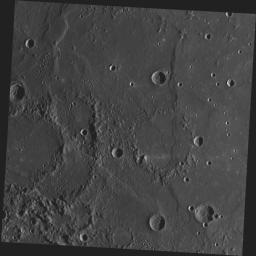This image, taken with the Wide Angle Camera (WAC), shows an area of smooth volcanic plains in Mercury's northern hemisphere. Looking closely, we can see the faint outline of an impact crater near the center of the image and two neighboring craters on the left side of the image. The crater floors were flooded with lava, leaving only the very tops of the crater rims visible. We can also see a number of wrinkle-like features, called wrinkle ridges, which are often found in smooth plains like these.
Date acquired: October 06, 2012
Image Mission Elapsed Time (MET): 258024090
Image ID: 2715174
Instrument: Wide Angle Camera (WAC) of the Mercury Dual Imaging System (MDIS)
WAC filter: 7 (748 nanometers)
Center Latitude: 17.37°
Center Longitude: 197.9° E
Resolution: 307 meters/pixel
Scale: This image is about 314 km (195 miles) across.
Incidence Angle: 77.9°
Emission Angle: 0.2°
Phase Angle: 78.0°
This image was acquired as part of MDIS's high-incidence-angle base map. The high-incidence-angle base map is a major mapping activity in MESSENGER's extended mission and complements the surface morphology base map of MESSENGER's primary mission that was acquired under generally more moderate incidence angles. High incidence angles, achieved when the Sun is near the horizon, result in long shadows that accentuate the small-scale topography of geologic features. The high-incidence-angle base map is being acquired with an average resolution of 200 meters/pixel.
The MESSENGER spacecraft is the first ever to orbit the planet Mercury, and the spacecraft's seven scientific instruments and radio science investigation are unraveling the history and evolution of the Solar System's innermost planet. Visit the Why Mercury? section of this website to learn more about the key science questions that the MESSENGER mission is addressing. During the one-year primary mission, MDIS acquired 88,746 images and extensive other data sets. MESSENGER is now in a year-long extended mission, during which plans call for the acquisition of more than 80,000 additional images to support MESSENGER's science goals.
These images are from MESSENGER, a NASA Discovery mission to conduct the first orbital study of the innermost planet, Mercury. For information regarding the use of images, see the MESSENGER image use policy.

 Planetary Data System
Planetary Data System












